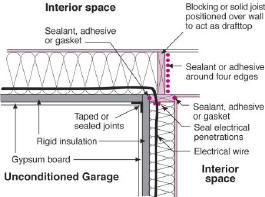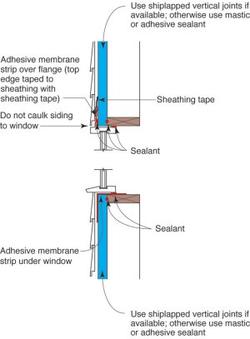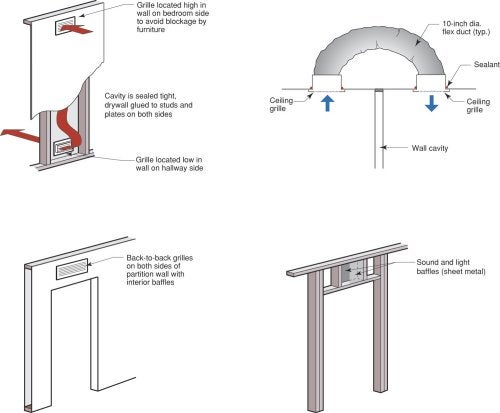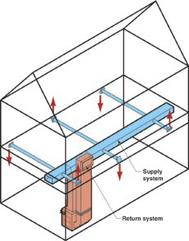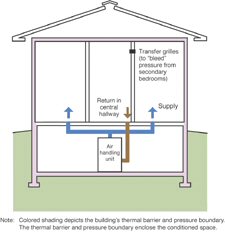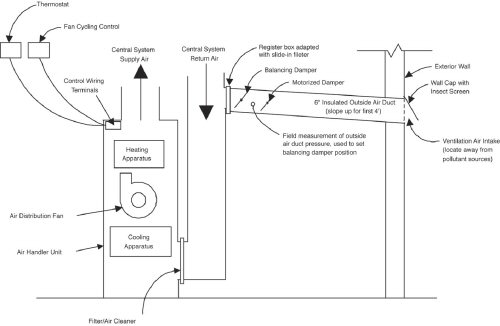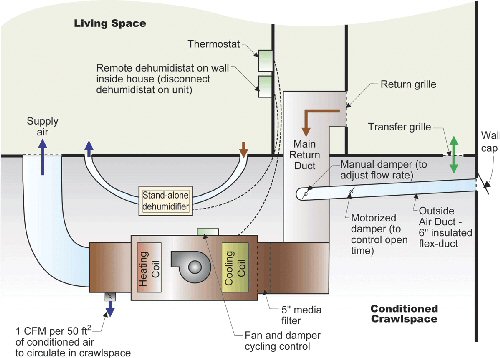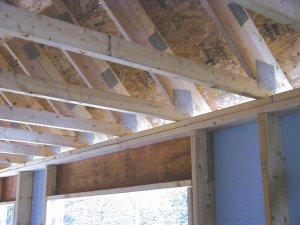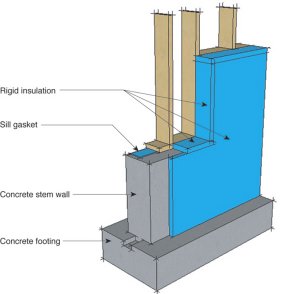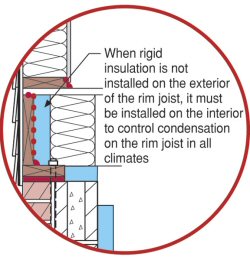This one-story enclosure with a basement is designed for Louisville, KY (Mixed-Humid Climate). It features a vented roof with cavity insulation in rafter cavities and rigid insulation at the underside of the rafters, and asphalt shingles. The 2x6 advanced wood frame walls are insulated with cavity insulation and rigid insulation on the exterior of wall sheathing. The rim joist is insulated with cavity insulation on the interior. The foundation wall is insulated with XPS or EPS rigid insulation on the interior along with cavity insulation in a wood stud wall. EPS rigid insulation or high density mineral fiberboard is installed under the foundation slab.
Enclosure Design
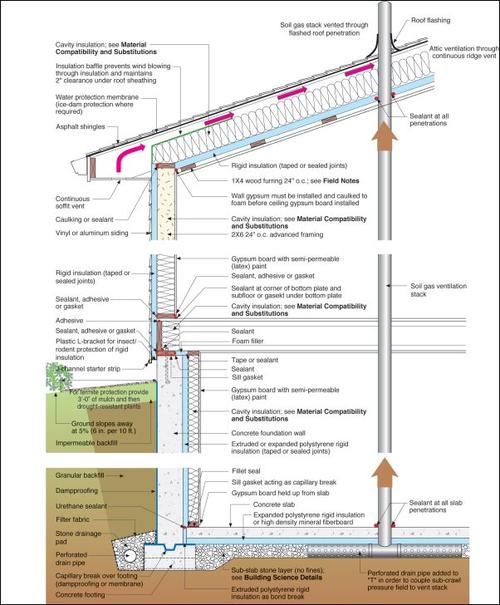
Construction Recommendations
- Foundation: Basement
- Above Grade Wall: Wood frame
- Cladding: Vinyl siding
- Attic: Vented cathedral ceiling
- Roof: Asphalt shingles
Building Science Notes
Ducts in conditioned space - This building profile is designed to accommodate HVAC equipment and ducts in either the living space or in the basement. HVAC ducts should not be run in exterior walls.
Cathedral roof assembly – The continuous eave-to-ridge venting just to the inside of the structural roof deck serves to thermally decouple everything to the exterior of this air space from everything to its interior (sometimes called a “cold” roof). It is the continuity of the air space, the thermal barrier, and the air barrier that makes this roof assembly work.
Figure 17
Air sealing details at transitions – Air sealing can be particularly difficult, but no less important, at assembly transitions such as band joists and between attached garages and living spaces. These are discussed below because they have proven to be a consistent challenge for builders.
- Band joists – Continuity of an exterior air barrier can be maintained at the band joist with sealed or taped housewrap or rigid foam insulation. Continuity of an interior air barrier can be maintained through a combination of cut foam blocks and sealant/caulk, rigid draftstopping (wood blocking) sealant/caulk, or spray foam. Note that neither cellulose nor fiberglass (batt or blown) can be used for the air barrier. The air barrier detail on second-story band joists is important because it is inaccessible (covered by structural/finish floor and ceiling finish) after construction. The air barrier/thermal barrier detail is important on ground floor band joists because of the thermal bridge that can occur at the top of basement and crawlspace foundation walls (as the result of the air barrier and thermal barrier moving from the outside to the inside of the building enclosure and termite inspection zones located at the top of basement and crawlspace foundation walls). Note that while fiberglass batts fulfill the requirement for protection from ignition in the open band joists, fiberglass batt material by itself cannot maintain the air barrier.
- Attached garages – The building enclosure surfaces shared between conditioned space and an unconditioned garage must have a continuous air barrier. See Figure 17 for details in terms of using sealants and rigid insulation to create a continuous air barrier between the attached garage and living space. For more details see Air Sealing / Air Drywall Approach Details.
Drying mechanisms – In any climate, vapor control is based on the relationships among the following: the permeability of wall components, the type of cladding (reservoir or non-reservoir), the presence/lack/nature of an air space, and the magnitude/duration of the vapor drive (based on the relationship between the exterior and interior moisture content and temperature differences). The type of sheathing and housewrap used in any wall assembly must be based on an understanding of these inter-relationships. See “Insulations, Sheathings, and Vapor Diffusion Retarders” for more information.
In Mixed-Humid climates, roof and wall assemblies are best designed to dry to both the exterior and interior. This is not always possible when rigid exterior insulating sheathings are used due to their low vapor permeability. With insulating sheathings only inward drying is possible. Accordingly, the majority of drying occurs to the interior during the summer months. Therefore, interior vapor barriers should not be installed. Note that there is a difference between an interior vapor barrier and an interior vapor retarder (see “Insulations, Sheathings, and Vapor Diffusion Retarders”). See Material Compatibility and Substitutions.Drainage plane, air barrier, vapor control – The drainage plane runs along the exterior surface of the foam sheathing. All vertical joints must be shiplapped, flashed, or sealed; all horizontal joints must be sealed or taped.
This building profile has a continuous air barrier on the (Airtight Drywall Approach on ceiling and walls; see Air Sealing / Air Drywall Approach Details) and on the exterior walls (the sealed rigid insulation).
In mixed climates, wall and roof assemblies can be designed to dry primarily to the exterior (during the heating season), to the interior (during the cooling season) or in both directions. This last, bi-directional drying potential, is generally the preferred approach. For more detailed discussion of the three approaches, see the discussion of wall and roof design in the Builder’s Guides. Since the permeability of the latex-painted gypsum board is greater than that of the XPS rigid insulation, this wall assembly is designed to dry more to the interior.Rough opening flashing – Flashing is always installed in the plane of drainage for continuity; this means that when a different material or “layer” makes up the drainage plane, window flashing details move accordingly. See Figure 18 and theWater Management Guide for sequential flashing details.
Advanced framing – The use of any non-structural sheathing means that cross bracing or some alternative for shear resistance is required. The reduced use of lumber, improved thermal performance and reduced drywall cracking are benefits of a comprehensive approach to advanced framing. See Advanced Framing Details for details.
Framing on slabs – Installing a capillary break between the sill plate and a concrete slab on all walls—exterior, interior, partition—is good practice. A closed cell foam sill sealer or gasket works well. Alternatively, a strip of sheet polyethylene can be used. This isolates the framing from any source of moisture that may be either in or on the concrete slab. Using sill sealer on all walls maintains the same wall height.
Soil gas ventilation – The sub-slab to roof vent system handles conditions that are difficult if not impossible to assess prior to completion of the structure—resultant confined concentrations of air-borne radon, soil treatments (termiticides, pesticides) methane, etc. The cost of this “ounce” of prevention is well balanced against the cost of the “pound” of cure.
Sub-slab stone bed - The four-inch deep, 3/4-inch stone bed functions as a granular capillary break, a drainage pad, and a sub-slab air pressure field extender for the soil gas ventilation system. Without it, a soil gas ventilation system is not practically possible and the only capillary break between the slab and ground is the polyethylene vapor barrier.
Thermal barrier – Cavity-warming exterior rigid insulation is important in this climate where the average monthly temperature for the coldest month of the year goes below 45°F. See Unvented Roofs for more information. The rule of thumb that BSC uses is 1/4-inch of rigid insulation per 1,000 heating degree days (HDD); one inch of rigid insulation works well for this climate. The heat loss through the crawlspace walls is significant enough to warrant insulation. Note that the insulation must comply with local codes for protection against ignition.
Basement and slab insulation – Although the basement walls and basement slab as shown clearly go beyond what is required by any code for this climate, this assembly assumes that the basement either is or will become a living space. It is not, however, the energy performance that is driving this design, but rather occupant comfort, dust mite control, and reduced potential for moisture problems that justifies the added cost of the assembly’s insulation. See the BSC technical resource, Basement Insulation Systems, for other basement wall assemblies that work.
Foundation sealant details – Note that the inside bead of sealant or caulk is an air sealing detail. The sealant between the two sheets of rigid insulation is actually a seal against insect and soil gas infiltration—this calls for a chemical bonding that can be accomplished with 2-part urethane.
Climate Specific Details
- Mechanical systems
- Heating and Cooling – Recommend a sealed combustion gas furnace - for energy efficiency and health/safety with the unit inside conditioned space (The “Louisville”—just under 5,000 heating degree days—is just about at the margin of heat pump winter-time efficiency; hence the recommendation for a gas heating and separate electric cooling system). Recommend a minimum 12 SEER AC unit - for energy efficient management of sensible load. See figures below. Follow appropriate sizing procedures—see the Cooling System Sizing Procedures for more detailed information.
- Ducting - Single return requires transfer grilles to provide path and avoid pressurizing bedrooms as shown in Figures 19a-d.
Figure 19a-d
- Mechanical ventilation
- Intermittent central-fan-integrated supply, designed to ASHRAE 62.2 rate, with fan cycling control set to operate the central air handler as much as 33% of the time, but not less than 25% of the time, occurring within at least every three hours to provide ventilation air distribution and whole-house averaging of air quality and comfort conditions ($125 to $150). Optionally include a normally closed motorized damper in the outside air duct with the AirCycler® FRV control (+$50 to $60). Optional dehumidification separate from cooling (+$300 to $350). See Figures 20, 21 and 22.
Supplemental dehumidification - Although high performance homes in this climate rarely require supplemental dehumidification, it is:
… one of three strategies appropriate for conditioned crawlspaces (see Building Science Notes),
… may be desired in homes with full basement foundations, and,
… is strongly recommended when occupants require humidity control (and high-efficiency air filtration) for asthma trigger control.
There are a number of different ways to accomplish supplemental dehumidification with varying costs and performance advantages (for a detailed discussion of supplemental dehumidification see Conditioning Air). Described below is one low-cost yet effective approach and one more costly but higher performance/systems-engineered approach:
1. Ducted stand-alone dehumidifier: This system is a "site-constructed" one consisting of an off-the-shelf standard dehumidifier ducted in the attic and controlled by a dehumidistat located in the living space. This arrangement of individual components has proven to be an effective and economical system for the production home building setting. The installed cost ranges from approximately $350 to $550. The system is comprised of a GE dehumidifier model AHG40FCG1 (dehumidifier located in attic in an insulated enclosure and ducted to living space), Honeywell dehumidistat model H8808C located in living space, and Honeywell switching relay (with transformer) model RA89A 1074. See Figure 22a. The selection of the dehumidifier is based largely on the fact that it has a blower wheel rather than paddle fan that moves air more efficiently in its ducted box configuration.
Note: The following manufacturers make Energy Star-qualified blower wheel stand-alone dehumidifiers:- LG Electronics (all models):
- Haier America (all models):
- Heat Controller (all BHD models use a turbo-impeller with turned blades):
- Or you can check the EPA Energy Star website for dehumidifiers from these manufacturers
2. Aprilaire 1700: This is a truly engineered, coherently manufactured, supplemental dehumidification system with built-in air filtration, ducted design, and a controls package that integrates central blower cycling for distribution, dehumidification and intermittent introduction of outside air ventilation. The system is also designed for flexibility-it can be connected to the conditioned space directly or to the central air distribution system in a number of configurations. It's also compact and lightweight enough to be set on or hung from most framing. The product cost for this system is currently about $1,100. For more information, see: http://aprilaire.com.
For more information on other high performance supplemental dehumidification systems, see: http://www.thermastor.com.Termite management – Termites are best managed with a three-pronged approach that deals with the three things termites need—cover from sunlight, moisture, and food (wood or paper):
- Reduced cover – Keep plantings 3 feet away from the building perimeter, thin the ground cover (wood mulch or pea stone) to no more than two inches depth for the first 18 inches around the building, and maintain any termite inspection zone on the foundation.
- Control moisture – Maintain slope away from building as shown, carry roof load of water at least three feet away from building, and make sure that irrigation is directed away from the building.
- Chemical treatment – Use an environmentally-appropriate soil treatment (such as Termidor®) and a building materials treatment (such as Bora-Care®) for termite-prone near-grade wood materials.
- Inter-relationship of first three points – Since a builder and a homeowner’s ability to employ or stick to each of the three strategies above will vary, make sure that an inability to fully employ one strategy is compensated for by complete rigor with the others. For example, if for some reason, chemical treatment of soil or building materials is not an option, then complete rigor in moisture control and ground cover is required.
Field Experience Notes
Termite control – Local codes and interpretations by building inspectors can make details involving rigid insulation difficult. Even though foam used on the interior of a basement wall is exempt from typical code restrictions on the use of rigid foam insulation, an inspection zone at the top of the insulated and studded-out wall could be incorporated without unduly comprising the thermal barrier at this location.
Air sealing – The air sealing details in the basement and at the first floor rim joist do not include any foam insulation or other materials that require protection from ignition. Note that if foam insulation were used at these locations, it could not be left exposed, according to the language used in many building codes.
Flashing details – Since the vinyl siding is a screened wall cladding system, flashing details should be accomplished in the plane of drainage (building paper or house wrap), not the cladding. Do not caulk siding and do not rely on "J"-channel as part of the drainage plane. (In other words, never consider vinyl siding, aluminum siding or any siding, for that matter--as the weather barrier).
Figure 23
HVAC commissioning – The most efficient equipment means little if the system is not set up and started up properly. Follow high performance start-up procedures (although this resource is primarily for refrigerant cooling systems, most of it applies to heat pumps).
Energy trusses – There are a number of different truss configurations that yield greater depth at the heel, but they vary quite a bit in cost. The truss shown here (sometimes called a “slider” truss) has proven to be among the most cost-competitive (see Figure 23). And of course, the pitch of the roof affects just how much insulation you can get at this location, regardless of the type of truss.
Advanced framing – For a technical resource that may help with resistance to advanced framing methods from local code officials, see the Building Safety Journal article written by Peter Yost of BSC.
Stepped foundation insulation detail – Maintaining thermal barrier continuity in stepped foundations has proven difficult, or easy, to neglect. Figure 24 shows how the rigid foam needs to be cut and placed.
Cathedral ceiling interior finish – To maintain air barrier continuity at the top of the exterior walls, a break with tradition is required—the wall gypsum board must go up before the ceiling board. 1x4 furring strips secured through the foam insulation to roof framing make hanging the ceiling a lot less painful. Using two-by rather than one-by furring provides the required space for shallow electrical boxes in the ceiling; i.e. the continuous thermal barrier and air barrier of the ceiling rigid insulation is maintained.
Material Compatibility and Substitutions
Exterior sheathing – The use of other common exterior sheathing materials—OSB, plywood or thin-profile structural sheathing (e.g. Thermo-ply®)—in this assembly must be done with recognition of the impact on heat and moisture transfer.
Both OSB and plywood are more vapor permeable than rigid foam insulation, a good thing when the cavity-warming ability of the rigid insulation is lost. But keep in mind that behind any reservoir cladding, the greater vapor permeability of the OSB or plywood would make a continuous 1-inch air space essential.
On the other hand, Thermo-ply® is less vapor permeable than rigid foam insulation and will pretty much eliminate drying potential to the exterior, a potential problem during the heating season, particularly the further north you build in this Mixed climate. Builders in the northern half of this climate region who use Thermo-ply® as an exterior sheathing should ensure that controlled ventilation and occupant use of point exhaust fans keep the interior relative humidity below 30% during the peak of their heating season.Figure 25
Rim joist insulation - Fiberglass cavity insulation at the rim joist is only acceptable if the exterior sheathing is cavity-warming rigid foam insulation that extends down over the entire rim joist. If non-insulating exterior sheathing is used at the rim joist then one of the following insulation details must be used at the rim joist (see Figure 25) to manage condensation potential:
- Spray foam insulation in the rim joist cavity.
- Fully air-sealed rigid insulation.
- Inset rim joist with rigid insulation between the exterior sheathing and the rim joist.
Drainage plane on rigid insulation – An alternative to flashing, shiplapping or sealing the XPS insulation for continuity of the drainage plane is to apply a housewrap to the outside of the insulation. The housewrap then becomes the continuous drainage plane.
Interior latex paint - The substitution of low permeability interior finishes (vinyl wall paper, oil-based paints) for latex paint is strongly discouraged as drying to the interior is important in mixed-humid climates.
Cavity insulation materials – Acceptable cavity insulation includes any that have a relatively high vapor permeability—cellulose, fiberglass, foam (as long as air sealing is accomplished by a separate component or system when cellulose or fiberglass is used). User discretion can be based on properties other than building science.
L-channel detail on cladding at base of exterior wall – Any stop can be used at the bottom, exposed edge of the rigid insulation to prevent insects and rodents intrusion, as long as it does not interfere with the foam’s function as the drainage plane.
Cast concrete foundation walls – If block is used instead of cast concrete for foundation walls, the bond beam becomes essential to maintain air barrier continuity at the top of the block wall.
Gypsum wallboard – Areas of potentially high moisture, such as bathrooms, basements, and kitchens, are excellent candidates for non-paper faced wallboard systems (e.g. James Hardie’s Hardibacker®, GP’s DensArmor®, USG’s Fiberock®). In addition, paper-faced gypsum board should never be used as interior sheathing or backer for tub or shower surrounds where ceramic tile or marble (any material with joints or grout lines) is used as the finish.
Flooring – Many finished flooring materials — either because of their impermeability (sheet vinyl, for example) or sensitivity to moisture (wood strip flooring, for example) — should only be installed over a slab with low w/c ratio (≈0.45 or less) or a slab allowed to dry (0.3 grams/24hrs/ft2) prior to installation of flooring. In general sheet vinyl flooring should be avoided.

